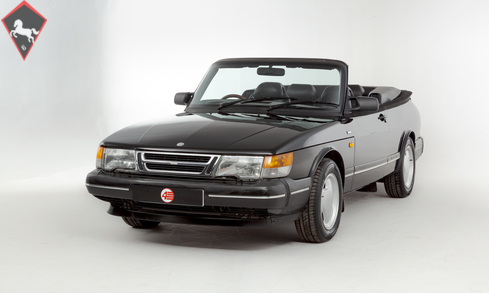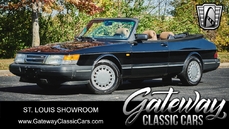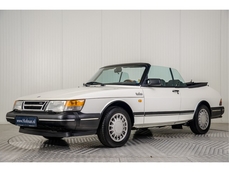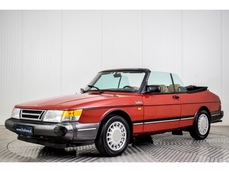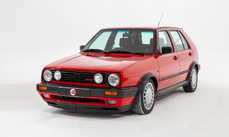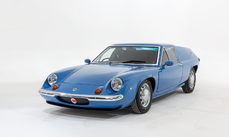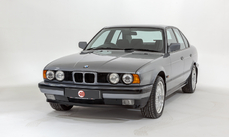Saab 900 16v Cabriolet 1992
General description :
Model History
The Saab 900 was produced from 1978 until 1998. The first generation (produced until 1993) is known as the "classic" while the 1994-1998 models are known as the "new generation”. The classic 900 was based on the 99 chassis while the later models used that of the Opel Vectra. General Motors’ influence from 1994 marked the end of Saab's technology-driven design philosophy and the beginning of the dilution of the Saab brand.
The 900 sported a deeply curved front windscreen, providing the best driver visibility, calling attention to the marque's aircraft legacy. Also underscoring their aircraft lineage, the 900's dashboard was curved to enable easy reach of all controls and featured gauges lit up from the front. Saab engineers placed all controls and gauges in the dashboard according to their frequency of use and/or importance, so that the driver need only divert their gaze from the road for the shortest possible time and by the smallest angle. This is why, for example, the oft-used radio is placed so high in the dashboard.
In keeping with the paradigm of its predecessor, the 99 model, the 900 employed a door design unique in automotive manufacturing, with an undercutting sweep to meet the undercarriage, forming a tight, solid unit when the door was closed. This feature also eliminated the stoop in the cabin at the footing of the door, as seen in automobiles of other manufacturers, thereby preventing water and debris from collecting and possibly entering the cabin or initiating corrosion, as well as enabling passengers to enter and exit the cabin without need to step over several inches of ledge.
The 900 underwent minor cosmetic design changes for 1987, including restyled front-end and bumpers that went from a vertical to a more sloped design; sheet metal body parts were unchanged. Being a small car factory, for economic reasons, Saab kept the basic undercarriage more or less unchanged throughout the 900's production run.
Production of the first 900 cabriolet started during the spring of 1986. The convertibles predominantly featured a turbocharged 16v engine but were also offered with a fuel-injected naturally aspirated engine, as featured here.
Equipment
Electric-folding roof, Tonneau cover with storage bag, Electric windows, Kenwood CD player with Bluetooth, Electrically adjustable door mirrors, Spare wheel and jack, Nardi wooden steering wheel, Lockable glovebox, Cigarette lighter, Spare key.
Exterior
The black paintwork is very well preserved throughout with only a few discreet areas showing age-related marks. Towards the front of the car the body is in good order with no major blemishes to report. The oversized bumpers and black trim are in fine fettle with no fading and just a few scuffs to be found on close inspection. The black electrically-operated soft-top works exactly as it should and remains in excellent condition having been replaced in 2015 at a cost of over £900. This example also comes with the rare tonneau cover and storage bag, both of which are in perfect condition.
Interior
The classic Saab interior is a very pleasing place to sit. The first thing you’ll notice is the beautiful 3-spoke wood rim Nardi steering wheel, a great looking option that feels lovely in-hand – the original steering wheel is still present. A tasteful Kenwood CD player with Bluetooth is in place for modern convenience. The seats are trimmed in black leather, a great colour combo with the black roof and bodywork. All the seats are in fine order with no major wear to be found on any of the bolsters or bases. Lifting the rear hatch you’ll find a clean load compartment with the alloy spare wheel and jack, which is located neatly beneath the removable floor panels.
ENGINE & TRANSMISSION
The Saab is equipped with a two-litre naturally aspirated 16v engine producing 123hp. On first turn of the key the car fires quickly into life and idles up to temperature smoothly. Despite its modest performance figures the 900i provides a smooth yet engaging drive with plenty of Swedish charm.
With just 119k miles to its name – reasonably low mileage in Saab terms – the engine pulls well and the auto ‘box shifts seamlessly through the gears. The car has recently been inspected on arrival at 4 Star, with a clean bill of health and MOT valid until May 2020.
WHEELS, TYRES & BRAKES
The retro 15-inch Saab Directional alloy wheels look fantastic and remain in good order all round with the exception of a few light curb marks. The wheels are shod in matching Pirelli Cinturato rubber; the front tyres are brand new and the rears have plenty of tread remaining. The brake pads and discs were replaced all round upon arrival with us.
History File
This charming 900i was first registered January 1992; it was sold through the supplying dealer Saab City, London. Within the History File the original Saab document pack is still present with all the manuals and booklets. The service booklet contains 19 stamps. Various invoices for replacement parts and health checks can be found along with old MOT certificates.
http://www.4starclassics.com/for-sale/saab-900i-16v-cabriolet-for-sale/
1992 Saab 900 16v Cabriolet is listed sold on ClassicDigest in Kingsley by 4 Star Classics for £7495.
Car Facts
Car type : Car Make : Saab Model : 900 Model Version : 16v Cabriolet Engine size : 2.0 Model Year : 1992 Sub type : Convertible Location : Hampshire
Sold
Seller Information
Sold
People who viewed this Saab 900 also viewed similar Saab listed at ClassicDigest
Other cars listed for sale by this dealer
About Saab
Saab, originally an acronym for Svenska Aeroplan Aktiebolaget (Swedish Aeroplane Company), began its journey as an aircraft manufacturer in 1937. Founded in Sweden, Saab's primary focus was on producing fighter planes and military aircraft. Over time, the company diversified its interests and ventured into automobile manufacturing, which eventually led to the creation of quirky yet innovative cars that stood out in the automotive industry.Fighter Plane Manufacturing:
Saab's history in the aviation industry was marked by its production of innovative fighter planes. One of its most iconic aircraft was the Saab 29 Tunnan, introduced in the early 1950s. The Tunnan was notable for its unique design, featuring a barrel-shaped fuselage, which earned it the nickname "The Flying Barrel." It was powered by a single jet engine and became Sweden's first domestically produced jet-powered fighter aircraft.
Following the success of the Tunnan, Saab continued to develop advanced military aircraft. The Saab 35 Draken, introduced in the late 1950s, was another milestone for the company. The Draken was a delta-winged interceptor known for its remarkable speed and distinctive double-delta wing configuration. Its innovative design allowed for excellent maneuverability and performance, making it a significant asset in Sweden's air defense arsenal for several decades.
Transition to Automobile Manufacturing:
In the late 1940s, Saab expanded its operations into the automotive industry. The company's first foray into car manufacturing resulted in the production of the Saab 92, which debuted in 1949. The Saab 92 was a compact and aerodynamic car powered by a two-cylinder, two-stroke engine. Its unconventional design, with a streamlined shape and front-wheel-drive layout, set it apart from other cars of its time.
As Saab continued to innovate, it introduced several notable models in the automotive market. The Saab 99, launched in the late 1960s, was a significant milestone for the company. It featured distinctive styling, including a wraparound windshield and a unique "hockey stick" profile, giving it a recognizable appearance. The Saab 99 also introduced technical advancements such as turbocharging, enhancing performance and fuel efficiency.
The evolution continued with the Saab 900, introduced in the late 1970s, which became one of the company's most iconic models. The Saab 900 was known for its robust build quality, innovative safety features, and unconventional design elements, including the signature wraparound windshield. It offered turbocharged engines and a versatile hatchback body style, catering to a niche market seeking individuality and practicality.
Technical Aspects and Quirks:
Saab cars were characterized by their technical innovations and unique features. Some of the standout technical aspects and quirks of Saab automobiles include:
Turbocharging: Saab was one of the pioneers in popularizing turbocharged engines in passenger cars, significantly enhancing power output without sacrificing fuel efficiency.
Safety Innovations: Saab prioritized safety and introduced various safety features, including reinforced passenger compartments, impact-absorbing structures, and advanced braking systems.
Aircraft-Inspired Design: The company incorporated design elements inspired by its aviation heritage, such as aerodynamic shapes, wraparound windshields, and unconventional styling cues.
Ergonomics and Practicality: Saab cars were known for their comfortable interiors, innovative ergonomics, and practical features like the ignition key placement between the front seats.
Quirkiness: Saab cars often featured unconventional design choices and solutions, appealing to a niche audience seeking something different from mainstream automobile offerings.
Saab's journey from a renowned fighter plane manufacturer to a builder of quirky yet innovative cars highlights its commitment to innovation, unique design, and technological advancement in both the aviation and automotive industries. Despite facing challenges and changes in ownership over the years, Saab's legacy endures through its distinct and unconventional approach to vehicle design and engineering.
